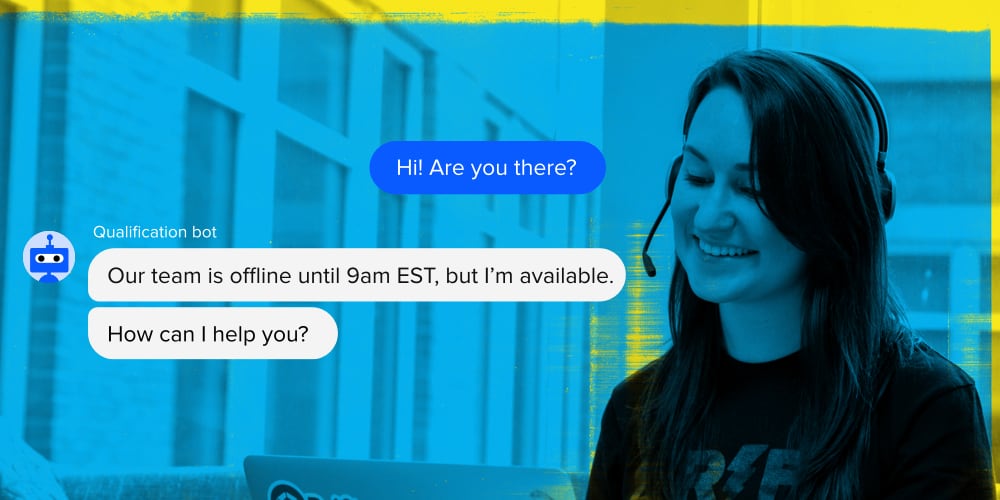
Most companies today prioritize the experience of their sales reps over their buyers. It’s seen in a number of ways – like putting business hours in a service level agreement (SLA). Doing this means a rep wouldn’t have to respond to a lead who came in on a Friday night until Monday morning. Not a great experience for the buyer…
When setting up your inbound SLAs, you have a choice – do you measure from your buyer’s perspective, or your sales rep’s?
Of course, you need to think about both, but only one can take priority – and that has to be the buyer’s experience.
Why It Matters
When a qualified lead comes in, the goal is to start a conversation with them, right?
They’ve done something that signals they’re interested, like:
- Chatting with a bot on your website
- Downloading an eBook
- Subscribing to your blog
- Signing up for a webinar/event
- Taking an action to trigger a lead score
And now based on the information you have, if they’re qualified, the goal is to move them into a sales conversation, and eventually, into revenue. We know the best way to do that is to respond in a personalized and authentic way – and the faster you can do it, the better your conversion rates will be.
To make sure your sales reps are doing this consistently, you’ll need a service level agreement that encourages the behaviors you want to see from your sales reps.
Building Your SLA
SLA Targets
Pickup rate:
We recommend using a target of 95% of leads picked up in 24 hours. This metric should be easy for your reps to maintain and should stay much closer to 100%.
Response time:
We recommend setting up two response time targets:
- Target: 2 hours
- Max: 24 hours
How This Impacts Rep Behavior
Research shows that if leads aren’t responded to within five minutes, there’s a 10X decrease in your odds of ever connecting with that lead. And if you don’t respond within 10 minutes, your odds of qualifying that lead decrease by 400%.
But these targets are hard for sales reps to hit consistently.
What if the rep is:
- On a call
- In a meeting
- Commuting to/from work
- In the bathroom
- Getting a coffee
The list goes on…
So set something a bit more generous like 2 hours and then if the lead isn’t responded to within 24 hours, reroute that lead to a new rep.
What’s more, setting response times that are hard to hit consistently will encourage what we like to call the “spray and pray” approach. Sure, the response time will look good, but that first touchpoint isn’t going to be very personalized or authentic – it’s going to be a copy and paste template with little-to-no thought put into it.
For more on SLA targets, best practices, and examples, check out The Measurable Lead Model here.
Business Hours Vs Actual Hours
If a qualified lead comes in during off-hours, should they be treated the same as a lead that comes in during business hours?
Many organizations want to set SLA levels within business hours, and on the surface it makes sense. Let’s say office hours are 8-5, how can they be held accountable to a 2-hour response time if they’re not in the office when a lead comes in? They can’t reply to leads while they’re sleeping!
Regardless, we do recommend using actual hours.
Here’s why: the prospect doesn’t care if your business is open or not.
If our primary belief is that creating a great prospect experience drives conversion to revenue, and a fast response time creates a great experience, then you need to use calendar hours in your SLA. And tools like Conversational Marketing and Drift Automation are here to help.
How This Impacts Rep Behavior
Let’s say our business hours are 8-5, and a lead comes in at 4:00 PM, should they get the same experience as someone that came in at 2:00 PM? Using a two hour target within business hours, the 4:00 PM lead doesn’t need to be responded to until 9:00 AM the next morning (17 hours later) to be within target. Now just imagine that lead came in on a Friday, the rep would have until Monday morning to respond. Would you still consider that a hot lead?
If you were measuring actual hours, the likelihood of your rep working that lead before 6:00 PM would increase substantially.
Something that we hear is that off-hour leads are skewing metrics, which could be true, but how many leads do you have coming in during off-hours? 5%, 20%, 50%? If the number of off-hour leads is substantial enough to skew your numbers, and you believe that getting back to prospects quickly makes an impact on your conversion rates, shouldn’t you have a dedicated team that works off-hour leads?
The goal of response time SLAs is to create a measurable improvement in the customer experience, which should translate to an increase in sales. By measuring by business hours you turn this into a vanity metric where your reps can meet the metric without creating the desired outcome.
Defining “Responded”
Next, we need to clearly define what it means to respond to a lead – what touchpoint takes them from “assigned” to “working” to give you the lead response time.
We’ve got a number of different types of touchpoints to look at:
- Phone call
- Personalized email
- Automated email
- LinkedIn (or other social) message
- Chatbot
We recommend excluding any automated messages and low-value touches from your lead response calculation.
Build Your SLA To Encourage The Behaviors You Want To See
Let’s circle back and ask this question again, in your lead response SLA, are you measuring from your buyer’s perspective or your sales rep’s?
You need to think about both, but only one can take priority – and that has to be the buyer’s experience.
Here’s how:
- Set response targets that will avoid the spray and pray approach, and encourage your reps to give a quick, personalized, and authentic response.
- Use actual hours instead of business hours in your SLA to make sure you’re giving a consistent prospect experience regardless of what time of day it is.
- Exclude automated and low-value touches to avoid skewing your metrics.
- Most importantly: In every decision you make, prioritize the buyer’s experience first, then figure out how to make it work for your sales team.
Want more lead management best practices? We’ve partnered with Drift on a free eBook: The Measurable Lead Model. Get it here.
Marko Savic is the CEO of FunnelCake, a Revenue Operations Platform that dramatically improves lead management and pipeline performance for fast growing SaaS organizations. Along with driving the growth of FunnelCake, Marko is a sought-after thought leader in the B2B SaaS revenue space and one of the founders of the RevOps movement. His seminal book “The RevOps Framework” helped an entire industry see the value in a centralized operations role. Most recently, Marko authored “The Measurable Lead Model”, a fresh look at how today’s lead models are broken and how a new lead model is needed to drive growth.
Editor’s Note: This is a guest post. Interested in contributing content to the Drift blog? Email Molly Sloan at msloan@drift.com.





